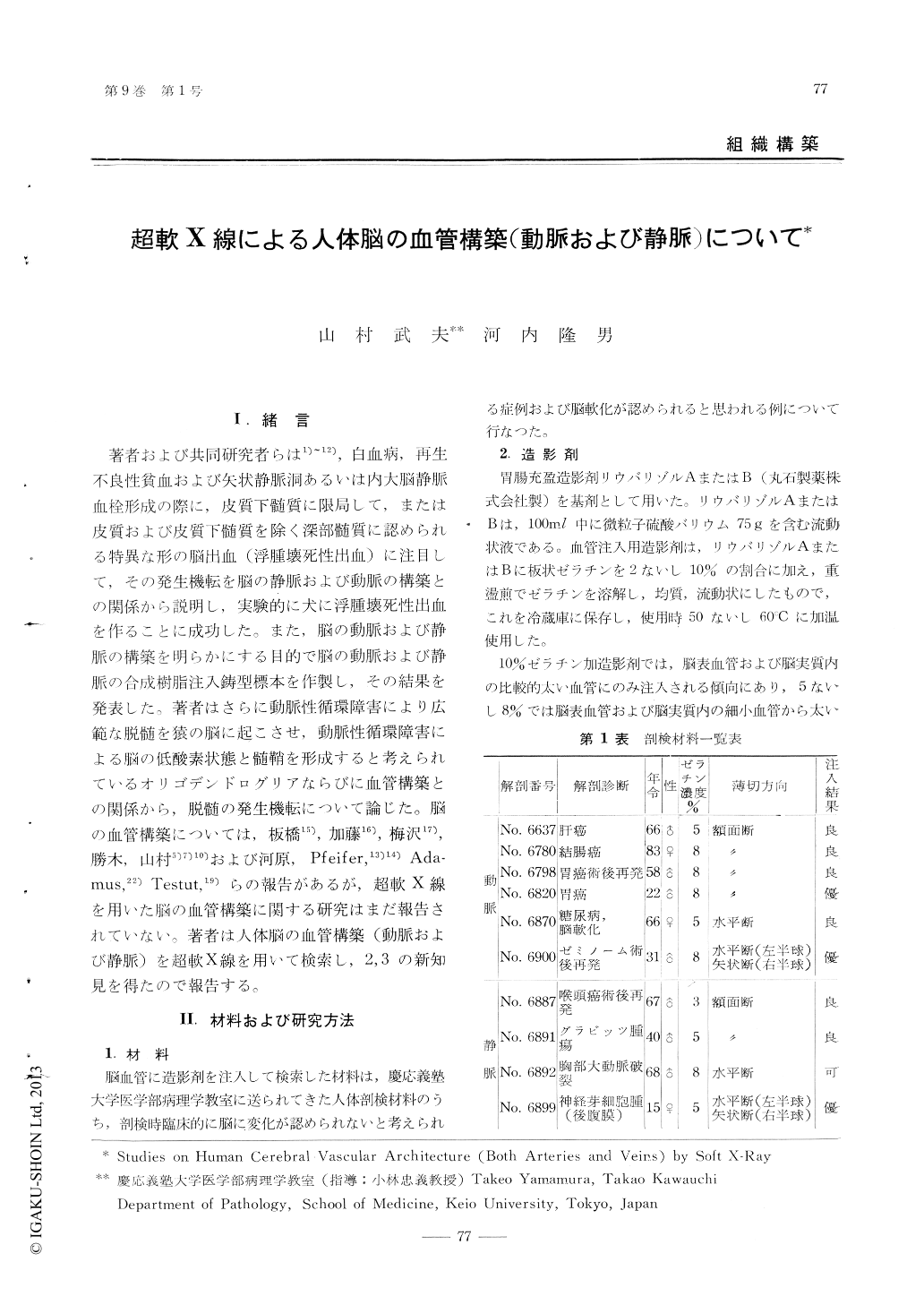Japanese
English
- 有料閲覧
- Abstract 文献概要
- 1ページ目 Look Inside
I.緒言
著者および共同研究者らは1)〜12),白血病,再生不良性貧血および矢状静脈洞あるいは内大脳静脈血栓形成の際に,皮質下髄質に限局して,または皮質および皮質下髄質を除く深部髄質に認められる特異な形の脳出血(浮腫壊死性出血)に注目して,その発生機転を脳の静脈および動脈の構築との関係から説明し,実験的に犬に浮腫壊死性出血を作ることに成功した。また,脳の動脈および静脈の構築を明らかにする目的で脳の動脈および静脈の合成樹脂注入鋳型標本を作製し,その結果を発表した。著者はさらに動脈性循環障害により広範な脱髄を猿の脳に起こさせ,動脈性循環障害による脳の低酸素状態と髄鞘を形成すると考えられているオリゴデンドロゲリアならびに血管構築との関係から,脱髄の発生機転について論じた。脳の血管構築については,板橋15),加藤16),梅沢17),勝木,山村5)7)10)および河原,Pfeifer,13)14)Adamus,22Testut,19)らの報告があるが,超軟X線を用いた脳の血管構築に関する研究はまだ報告されていない。著者は人体脳の血管構築(動脈および静脈)を超軟X線を用いて検索し,2,3の新知見を得たので報告する。
1. The studies on the human cerebral vascular architecture including both veins and arteries were made. The material was obtained from the autopsy cases with the injection of barium sulfate suspension with 2-10% gelatine through the bilateral A. carotis communis or the bilateral V. Jugularis interna. The brain Was fixed in 10% formal solution and cut with coronal, sagital or transverse sections with thickness of 0.5-3.0 cm. Then these sections were photographed by a soft X-ray apparatus (EM Type, Nippon Softex Co., LTD.).
2. Thi, studies on distributions of the cerebral arteries showed similar findings to that of Itabashi's description (Tokyo journal of medical science, 42(6): 1218-1304, 1928).
3. However, in the venous system, there were found veins which have been previously misdescribed or previously not been described. They are as follows;
1) The previously listed in the literatures V. hippocampica anterior and posterior were not, distributed in the Pes hippocampi. The veins in the Pes hippocampi arize from the surface of the Pes hippocampi, run between the Fimbria hippocampi and the Cyrus dentatus and join the vein from the Sulcus hippocampi which collects the veins from the central parts of the Pes hippocampi. The veins from the anterior parts of the Pes hippocampi run anteriorily and empty into the V. basalis; on the contrary, the veins from. the posterior Parts of the Pes hippocampi run posteriorily and empty into the V. calcarina. The former is named "V. hippocampica anterior" and the latter "V. hippocampica posterior".
2) The V. calcarina has two types. The one is that the veins distributed in the Cornu posterius of the Ventriculus lateralis empties into the V. cerebri intermit and the other is that the veins chiefly from the internal wall of the Cornu posterius empty into the V. cerebri interna and the veins mainly from the external wall of the cornu posterius as well as most parts of the wall of the Cornu inferius without the Pes hippocampi run anteriorily along the superior internal wall of the Cornu inferius and empty into the V. basalis.
3) The veins arizing from large posterior parts of the Nucleus lateralis thalami and of the Nucleus medialis thalami empty into the V. basalis and the V. calcarina and they are named "Vv. thalamicae posteriores laterales".
4) The veins from upper parts of the Nucleus anterior thalami and of the Nucleus lateralis thalami empty into the V. chorioidea superior and they are named "Vv. thalamicae dorsales laterales".
5) The veins from an upper part of the Nucleus medialis thalami, a part of the Nucleus anterior thalami and an upper area of the Ventriculus tertius empty into the V. cerebri interna which are named "Vv. thalamicae dorsales mediales".
6) The veins from posterior parts of the Putamen, of the Globus pallidus and of the Crus posterius of the Capsula irterna, the Radiatio acustica and Rail optica run posteriority and empty into the V. calcarina. They are named "Vv. corporis striati posteriores".
7) The veins in the Claustrum consists of the Vv. corporis striati superiores and inferiores. Vv. medullares and Vv. subcorticales.
4. The presence of the l Aa. and Vv. corticales, Aa. and Vv. subcorticales and the Aa. and Vv. medullares were reassured (Takeo Yamamura, M. D., Keio Journal of Medicine, 10 (3), September 127-152, 1961).

Copyright © 1965, Igaku-Shoin Ltd. All rights reserved.


